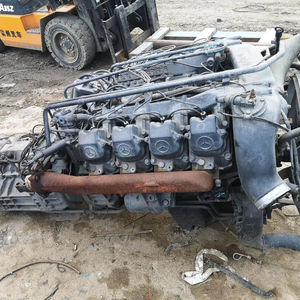Discovering the Inner Workings of a Compact Lorry's Engine System
As chauffeurs, we usually take for provided the detailed processes that take place within the boundaries of our car's engine system. In this expedition of a portable vehicle's engine system, we will certainly untangle the internal workings of this mechanical harmony, shedding light on the mysteries that drive us ahead on our day-to-day journeys.
Burning Refine Overview
The combustion procedure in a compact car's engine system is an essential mechanism that effectively transforms fuel into power to power the lorry. This process occurs within the burning chamber of the engine, where gas and air mix, ignite, and produce controlled surges. The burning procedure contains 4 main stages: intake, power, compression, and exhaust.
During the intake stage, the piston moves downward, attracting in a combination of air and fuel into the burning chamber. This downward motion produces the power required to drive the lorry. This cyclic burning procedure is basic to the procedure of a small lorry's engine system, guaranteeing reliable energy conversion for propulsion.
Piston and Cylinder Communication

The piston's precise fit within the cylinder is crucial for maintaining optimal compression and stopping power loss during combustion. Limited clearances between the piston and cylinder walls make certain effective sealing, allowing the piston to relocate smoothly without enabling gases to leakage past. Proper lubrication is likewise crucial to minimize rubbing and wear in between these elements, enhancing longevity and performance.
Moreover, the design and materials used in making the piston and cyndrical tube impact engine effectiveness and longevity. Modern engines often utilize light-weight yet durable materials like light weight aluminum alloys for pistons and cyndrical tube liners to minimize inertia and boost thermal performance. Overall, the harmonious interaction in between the piston and cylinder is basic to the engine's capability and overall performance.
Fuel Injection System Capability
Gas injection systems in small lorry engines play a vital role in exactly providing fuel to the combustion chamber for effective and controlled ignition. The fuel shot system operates by infusing fuel right into the burning chamber at the optimal minute throughout the engine's procedure (opel corsa engine). This specific timing ensures that the fuel mixes equally with the air for appropriate combustion, resulting in boosted fuel efficiency and reduced exhausts
There are mainly two kinds of fuel injection systems used in compact car engines: port fuel injection (PFI) and straight gas shot (DFI) PFI systems inject gas right into the intake port before the intake shutoff, while DFI systems inject gas directly into the combustion chamber. Both systems have their benefits, with DFI supplying far better fuel atomization and PFI supplying a much more economical service.
Understanding Engine Air Conditioning Devices
Effective operation of a portable lorry's engine counts heavily on the efficiency of its cooling systems. Engine air conditioning is vital to stop overheating, which can result in severe damage and lowered performance. The cooling system in a portable lorry usually consists of numerous parts functioning together to regulate More Info the engine temperature level. One essential component is the radiator, which makes use of coolant to soak up warm from the engine. As the hot coolant flows with the radiator, it launches warmth into the air, cooling down prior to returning to the engine. The water pump flows the coolant via the engine and radiator, making sure a regular flow to control temperature level. In addition, the thermostat aids manage the coolant flow to maintain optimum engine temperature. Some vehicles also have cooling fans that activate when additional air conditioning is needed, such as throughout hefty website traffic or hot climate. Recognizing these engine air conditioning mechanisms is vital for maintaining the efficiency and longevity of a small vehicle's engine system.

Exhaust System Elements Explained
The optimal functioning of a small vehicle's engine air conditioning mechanisms depends on a complementary system referred to as the exhaust system, which consists of different crucial parts for making sure reliable discharges and engine efficiency. The exhaust system consists of elements such as the exhaust manifold, catalytic converter, muffler, and why not find out more tailpipe. The exhaust manifold collects exhaust gases from the engine's courses and cylinders them to the this article catalytic converter. The catalytic converter after that transforms dangerous contaminants in the exhaust into less dangerous exhausts prior to releasing them through the muffler and tailpipe.
One vital component of the exhaust system is the oxygen sensor, which checks the oxygen levels in the exhaust gases to help control gas consumption and make sure optimal engine efficiency. opel corsa engine. Additionally, the resonator may exist in some exhaust systems to minimize sound levels. Generally, the exhaust system plays an essential role in maintaining engine effectiveness, minimizing damaging exhausts, and ensuring a quieter driving experience for compact automobile owners

Verdict
To conclude, the portable lorry's engine system is a complicated combination of components that function with each other to help with the burning process, convert gas into energy, and eliminate waste gases. Understanding the inner operations of the engine system, including the piston and cylinder communication, gas injection system, engine cooling devices, and exhaust system parts, is essential for keeping ideal efficiency and efficiency of the vehicle.
The burning process in a compact car's engine system is a vital device that effectively converts fuel into power to power the automobile.Fuel injection systems in portable lorry engines play a crucial duty in precisely providing fuel to the combustion chamber for controlled and efficient ignition.There are largely two kinds of fuel injection systems used in portable automobile engines: port fuel injection (PFI) and direct fuel shot (DFI) Comprehending these engine cooling systems is crucial for keeping the efficiency and durability of a compact automobile's engine system.
The ideal performance of a portable car's engine air conditioning systems depends on a complementary system known as the exhaust system, which consists of numerous important elements for making certain effective exhausts and engine performance.